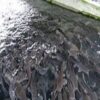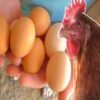- このトピックは空です。
- 投稿者投稿
- 3月 22, 2025 6:39 am #600217

The African Giant Snail (Archachatina marginata) is a highly valued agricultural resource, particularly in regions where it forms a significant part of the local diet. Optimizing their growth rate and reproductive performance is crucial for successful snail farming.
A key factor influencing these parameters is the dietary protein provided to the snails. This article explores the impact of different protein sources and varying protein levels on the growth rate and reproductive output of Archachatina marginata, highlighting the importance of a balanced diet for efficient snail production.
1. Protein Sources and Their Nutritional Profiles
Various protein sources can be incorporated into snail feed formulations. These sources vary in their amino acid profiles, digestibility, and cost. Common options include soybean meal, groundnut cake, fishmeal, and leaf meals from plants like cassava and moringa. Soybean meal is a widely used protein source due to its high protein content and balanced amino acid profile.
Fishmeal, while rich in protein and essential amino acids, can be expensive and may raise environmental concerns. Leaf meals offer a sustainable and cost-effective alternative, particularly in regions where these plants are abundant.
However, the protein content and digestibility of leaf meals can vary. Understanding the nutritional profile of each protein source is crucial for formulating a balanced diet.
2. Optimal Protein Levels for Growth Rate
The growth rate of Archachatina marginata is directly influenced by the protein content of their diet. Studies have shown that snails require a specific range of protein levels to achieve optimal growth. Insufficient protein intake can lead to stunted growth, while excessive protein can be wasteful and potentially harmful. The optimal protein level may vary depending on the age and stage of development of the snails. Juvenile snails, for example, require higher protein levels to support rapid growth. Research is needed to determine the precise protein requirements for different growth stages.
3. Impact of Protein on Reproductive Performance
Protein plays a crucial role in the reproductive performance of Archachatina marginata. Adequate protein intake is essential for the development of reproductive organs and the production of eggs. Studies have investigated the effects of different protein levels on egg production, hatching rate, and juvenile survival.
Insufficient protein can lead to reduced egg production and poor hatching rates. Conversely, a balanced protein intake can enhance reproductive output and improve the viability of offspring.
4. Amino Acid Balance and Digestibility
The amino acid balance and digestibility of protein sources are critical factors in snail nutrition. Snails require a specific balance of essential amino acids for optimal growth and reproduction. Protein sources that are deficient in certain amino acids can limit growth, even if the overall protein level is adequate.
Digestibility refers to the proportion of protein that can be absorbed and utilized by the snail. Protein sources with high digestibility are more efficient in promoting growth and reproduction.
Research on the amino acid requirements and digestibility of different protein sources is essential for formulating effective snail feed.
5. Formulating Cost-Effective and Sustainable Diets
Developing cost-effective and sustainable snail feed formulas is crucial for the economic viability of snail farming. Utilizing locally sourced ingredients and minimizing reliance on expensive protein sources can reduce production costs. Incorporating leaf meals and other plant-based protein sources can enhance sustainability and reduce environmental impact.
Optimizing protein levels and amino acid balance can improve feed efficiency and reduce waste. Research on alternative protein sources and feed formulations is essential for developing sustainable and cost-effective diets for Archachatina marginata.
The dietary protein provided to Archachatina marginata significantly impacts their growth rate and reproductive performance. Understanding the nutritional profiles of different protein sources, optimizing protein levels, and ensuring amino acid balance and digestibility are essential for formulating effective snail feed.
Developing cost-effective and sustainable diets that utilize locally sourced ingredients is crucial for the long-term success of snail farming.
Read Also: The Impact of Snail House Materials and Construction on Snail Growth, Health, and Disease Prevention
- 投稿者投稿
- このトピックに返信するにはログインが必要です。






